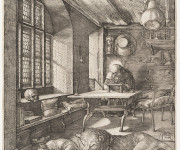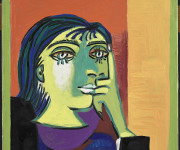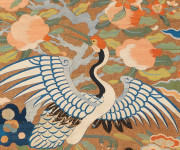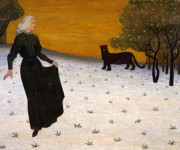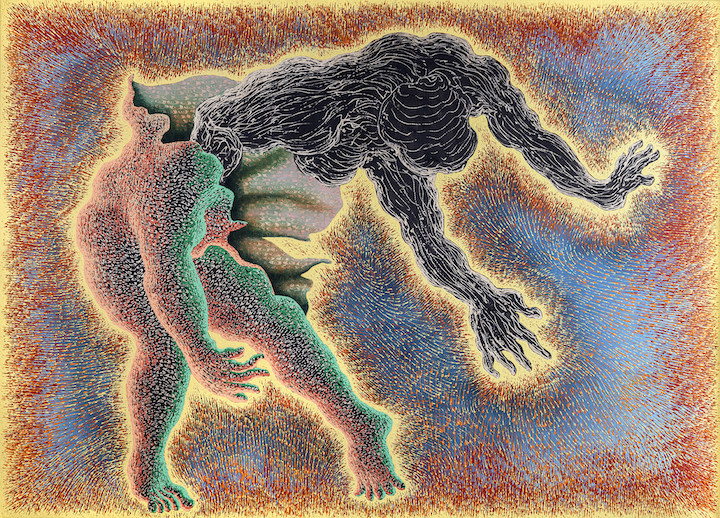
Didier William. Moult 1, 2023. Acrylic, ink, oil, wood carving on panel 52 x 72 in. Image courtesy of the artist and Altman Siegel, San Francisco, © Didier William
The Frist Art Museum is set to kick off 2025 with an extraordinary exhibition: M. Florine Démosthène and Didier William: What the Body Carries. This vibrant multimedia show explores themes of memory, heritage, and transformation through the eyes of two acclaimed Haitian American artists. On view from January 31 through May 4, 2025, in the Gordon Contemporary Artists Project Gallery, the exhibition presents a stunning collection of figurative paintings, collages, and sculptures that reflect the complexity of identity and migration.
The Power of Heritage and Hybrid Identity
Both M. Florine Démosthène and Didier William draw from their Haitian roots to tell nuanced stories of immigrant life, weaving cultural memory with a sense of transformation. Démosthène, born in New York but raised between the U.S. and Haiti, and William, who moved to Miami from Port-au-Prince as a child, have spent their careers navigating the intersections of history, spirituality, and personal experience.
Their works explore how immigrant bodies carry not just memories but a “hybrid reality,” shaped by both the homeland left behind and the new worlds they inhabit. “This project offers an opportunity to consider the connections and departures between the work of two artists of Haitian descent,” notes Senior Curator Katie Delmez. The exhibition pushes back against oversimplified narratives about immigration, offering instead a richly layered look at survival, resilience, and creative expression.
A Visual Language of Transformation
Both artists’ works inhabit imagined spaces—dreamlike geographies that seem to hover between Haiti and the United States. Their use of the human form transcends boundaries of gender, race, and identity, referencing the divine twins of Haitian Vodou, Marassa Jumeaux, as a symbol of duality and fluidity.
Eyes as a Motif: The emphasis on eyes is a recurring element in their works, symbolizing the desire to be seen but also deflecting judgment. Démosthène uses glitter to animate the eyes of her figures, creating a luminous, otherworldly effect. Meanwhile, William carves hundreds of eyes into his wooden panels, layering meaning and texture into his intricate compositions.
Démosthène’s pieces often lean into the spiritual. Her collages and 3D-printed sculptures feature motifs that evoke Haitian and West African mythology, such as votive statues and shimmering, cherub-like forms. Works like What We Know & What We Don’t Know transform everyday materials into objects that feel sacred, mysterious, and alive.
William, on the other hand, grounds his art in personal and historical narratives. Pieces like Redemption, Resurrectionreflect on his childhood in Miami and the struggles faced by his family. In one standout work, he portrays his brother as a savior figure fighting off bullies—a deeply personal story elevated into myth.
The theme of molting—shedding one’s old skin to grow—is central to William’s art, particularly in works like Moult I. For him, it’s a poignant metaphor for the immigrant experience: leaving behind aspects of the past to adapt and thrive in a new environment.
Bilingual Access and Public Programming
The exhibition ensures inclusivity with selected gallery texts available in Haitian Creole. It also features an essay by Grace Aneiza Ali, a Guyanese-born curator specializing in art and migration, adding further depth to the cultural conversation.
To celebrate the opening, the museum will host a conversation with both artists and curator Katie Delmez on January 31. The talk promises a behind-the-scenes look at the inspirations and processes behind What the Body Carries.
M. Florine Démosthène: A graduate of Parsons School for Design and Hunter College, Démosthène has received numerous awards, including the Joan Mitchell Foundation grant. Her works have been shaped by time spent in Haiti, Ghana, and the U.S., and her art reflects a global perspective rooted in personal history.
Didier William: William studied at the Maryland Institute College of Art and Yale University and is currently a professor at Rutgers University. Known for his intricate wood carvings and bold use of colour, William has earned accolades like the Louis Comfort Tiffany Foundation Grant and the Pew Fellowship.
Dates: January 31–May 4, 2025
Location: Frist Art Museum, Gordon Contemporary Artists Project Gallery
Opening Talk: January 31, noon
This exhibition is supported by the Gordon CAP Gallery Fund, Clay Blevins, The Frist Foundation, the Tennessee Arts Commission, and the National Endowment for the Arts.
What the Body Carries isn’t just an exhibition—it’s a profound exploration of heritage, transformation, and the many ways identity shapes and reshapes us. Don’t miss the chance to experience this powerful celebration of Haitian American artistry.

